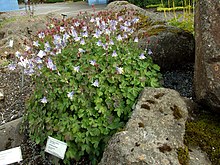Aquilegia ottonis
| Aquilegia ottonis | |
|---|---|

| |
| Aquilegia ottonis growing in Reykjavík Botanic Garden | |
| Scientific classification | |
| Kingdom: | Plantae |
| Clade: | Tracheophytes |
| Clade: | Angiosperms |
| Clade: | Eudicots |
| Order: | Ranunculales |
| Family: | Ranunculaceae |
| Genus: | Aquilegia |
| Species: | A. ottonis
|
| Binomial name | |
| Aquilegia ottonis | |
| Synonyms[1] | |
Aquilegia ottonis is a perennial flowering plant in the family Ranunculaceae, endemic to Greece.[1]
Description
[edit]Aquilegia ottonis grows to 15–20 cm (5.9–7.9 in) in height, with branching stems and white, cream, pale bluish,[2] or blue-purple[3] flowers, the petals having incurved and slightly hooked nectar spurs which are light violet-blue in colour.[2]
Taxonomy
[edit]Aquilegia ottonis is part of the Aquilegia olympica aggregate, together with Aquilegia olympica itself, Aquilegia dinarica, and Aquilegia champagnatii.[4]
The taxonomy of the species differs between authorities. It was considered by Arne Strid to comprise three subspecies:[2]
- A. ottonis subsp. amaliae (Heldr. ex Boiss.) Strid,[5] now treated in Plants of the World Online as a separate species, Aquilegia amaliae.[6]
- A. ottonis subsp. ottonis Boiss., now often considered a synonym of Aquilegia ottonis rather than a subspecies thereof.[7] Other authorities consider the status of this name unresolved.[8]
- A. ottonis subsp. taygetea (Orph.) Strid,[5] now treated in Plants of the World Online as a separate species, Aquilegia taygetea.[9]
In 2009, Aquilegia vulgaris var. speluncarum Lacaita was reclassified as A. ottonis subsp. speluncarum (Lacaita) Del Guacchio.[4] Both these names are now considered to be synonyms of Aquilegia champagnatii.[10][11]
Etymology
[edit]Aquilegia ottonis is named after King Otto of Greece,[12] the specific epithet 'ottonis' being the third declension in Latin of 'Otto'.[13]
Distribution and habitat
[edit]Aquilegia ottonis is endemic to Greece, in the vicinity of Mount Aroania in the northern Peloponnese and Mounts Giona and Parnassus on the other side of the Gulf of Corinth in central Greece.[14][15] It grows in ravines at altitudes of 1,300–1,800 m (4,300–5,900 ft), preferring north-facing slopes.[2]
Records of the species in the Alburni mountains in Italy[16] are now classified as Aquilegia champagnatii,[10] and those in Albania[14] as Aquilegia amaliae.[6]
Ecology
[edit]Aquilegia ottonis flowers from mid-May to the end of July.[2] Based on pollination syndromes, it is thought to be pollinated by bumblebees.[3]
Conservation
[edit]The species has not been assessed for the IUCN Red List.[17] Under IUCN criteria,[15] the species is considered vulnerable to extinction in Greece.[18][19]
References
[edit]- ^ a b c "Aquilegia ottonis Orph. ex Boiss." Plants of the World Online. Royal Botanic Gardens, Kew. Retrieved 23 November 2024.
- ^ a b c d e Strid, Arne (1986). Mountain Flora of Greece. Vol. I. CUP Archive. pp. 227–228. ISBN 978-0-521-25737-4. Retrieved 23 November 2024.
- ^ a b Bastida, Jesús M.; Alcántara, Julio M.; Rey, Pedro J.; Vargas, Pablo; Herrera, Carlos M. (4 December 2009). "Extended phylogeny of Aquilegia: the biogeographical and ecological patterns of two simultaneous but contrasting radiations". Plant Systematics and Evolution. 284 (3–4): 171–185. Bibcode:2010PSyEv.284..171B. doi:10.1007/s00606-009-0243-z. hdl:10261/36746. ISSN 0378-2697.
- ^ a b Del Guacchio, Emanuele (1 July 2009). "Aquilegia vulgaris var. speluncarum Lacaita (Ranunculaceae): an enigmatic columbine from the Campanian Apennines, S Italy". Willdenowia. 39 (1): 63–68. doi:10.3372/wi.39.39106. ISSN 0511-9618.
- ^ a b "Aquilegia ottonis Orph. ex Boiss." World Flora Online. Retrieved 23 November 2024.
- ^ a b "Aquilegia amaliae". Plants of the World Online. Royal Botanic Gardens, Kew. Retrieved 23 November 2024.
- ^ "Aquilegia ottonis (AQIOT)". gd.eppo.int. 2014-12-09. Retrieved 2021-03-25.
- ^ "Aquilegia ottonis subsp. ottonis". rhs.org.uk. Royal Horticultural Society. Retrieved 2021-03-26.
- ^ "Aquilegia taygetea Orph". Plants of the World Online. Royal Botanic Gardens, Kew. Retrieved 23 November 2024.
- ^ a b "Aquilegia champagnatii Moraldo, Nardi & la Valva". Plants of the World Online. Royal Botanic Gardens, Kew. Retrieved 23 November 2024.
- ^ "Aquilegia ottonis subsp. speluncarum (Lacaita) Del Guacchio". Plants of the World Online. Royal Botanic Gardens, Kew. Retrieved 23 November 2024.
- ^ Dimopoulos, Panayotis; Raus, Thomas; Bergmeier, Erwin; Constantinidis, Theophanis; Iatrou, Gregoris; Kokkini, Stella; Strid, Arne; Tzanoudakis, Dimitrios (2013). "Vascular Plants of Greece: An annotated checklist". Englera (31): 1–372. ISSN 0170-4818. JSTOR 24365847.
- ^ Rydberg, P. A. (1901). ""When in Rome do as the Romans do"". Torreya. 1 (6): 61–65. ISSN 0096-3844. JSTOR 40593966.
- ^ a b Kyriakopoulos, Charalambos; Kamari, Georgia (2016). "The rediscovery of Aquilegia ottonis subsp. taygetea (Ranunculaceae), an endemic taxon of S. Peloponnisos, Greece". Botanika Chronika. 21: 75–82 – via ResearchGate.
- ^ a b "Flora". www.fdchelmos.gr. Management Body of Chelmos Vouraikos. Archived from the original on 2020-01-29. Retrieved 2021-03-26.
- ^ Moggi, Guido (1955-01-01). "La Flora Del Monte Alburno (appennino Lucano)". Webbia. 10 (2): 461–645. Bibcode:1955Webbi..10..461M. doi:10.1080/00837792.1955.10669628. ISSN 0083-7792.
- ^ "Aquilegia ottonis Orph. ex Boiss". European Environment Agency. Retrieved 23 November 2024.
- ^ Bandi, Antonia (2012). Σπάνια και απειλούμενα φυτά της Ελλάδας: κατανομή, απειλές και κατάσταση διατήρησης in situ και ex situ [Rare and Threatened Plants of Greece: distribution, threats and conservation status in situ and ex situ] (PDF). Aristotle University of Thessaloniki (Master Thesis) (in Greek). Aristotle University of Thessaloniki. Archived (PDF) from the original on 2021-12-15. Retrieved 2021-03-26.
- ^ "NatureBank - Βιότοπος NATURA - OROS CHELMOS KAI YDATA STYGOS". filotis.itia.ntua.gr. Retrieved 2021-03-26.
Further reading
[edit]- "NatureBank - Φυτό - Aquilegia ottonis - ottonis". filotis.itia.ntua.gr (in Greek). Retrieved 2021-03-26.
External links
[edit] Media related to Aquilegia ottonis at Wikimedia Commons
Media related to Aquilegia ottonis at Wikimedia Commons
